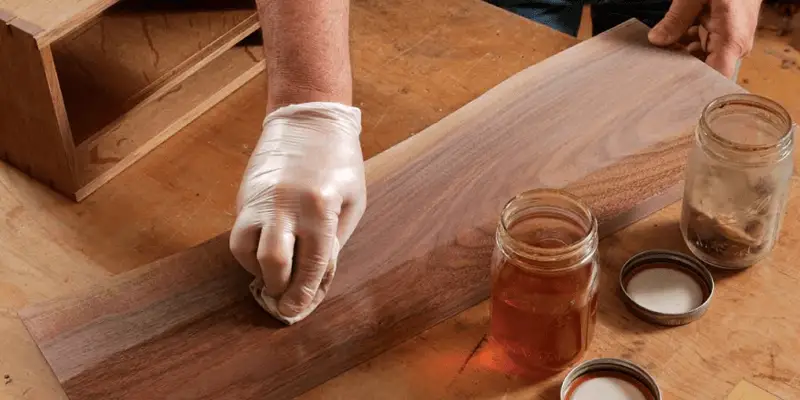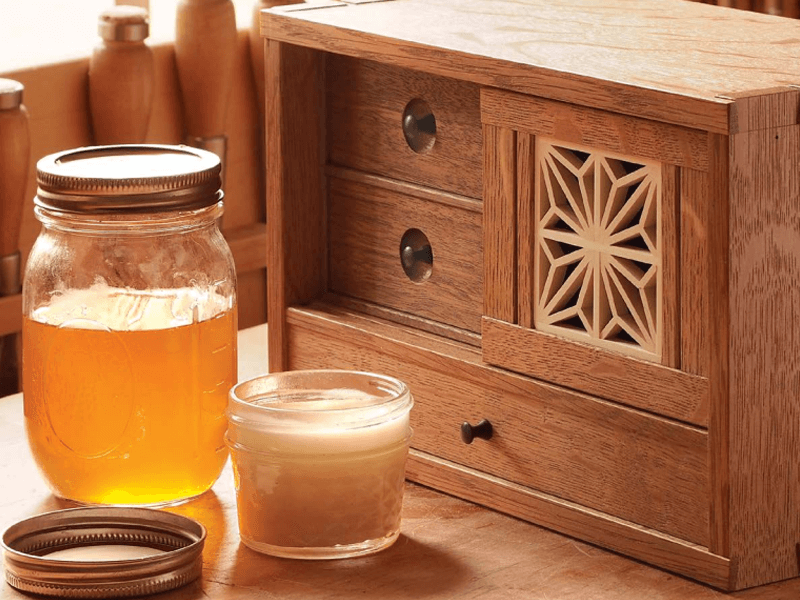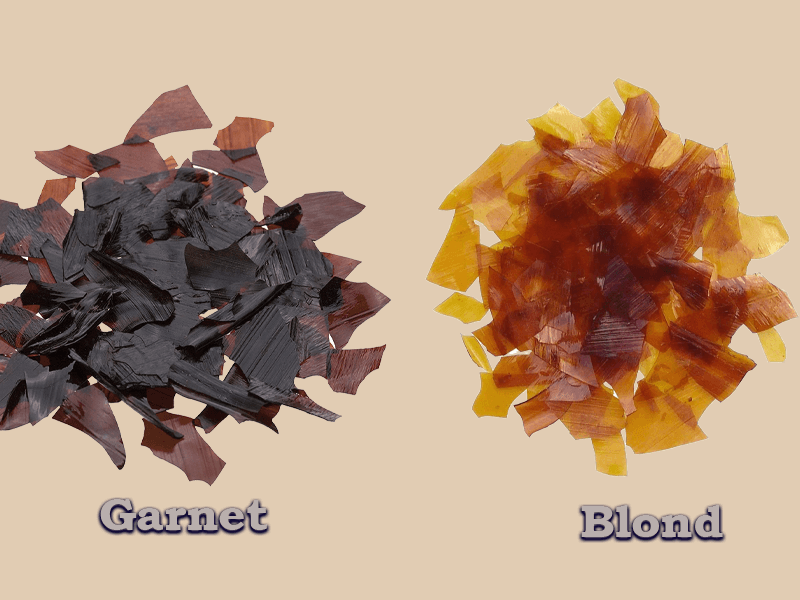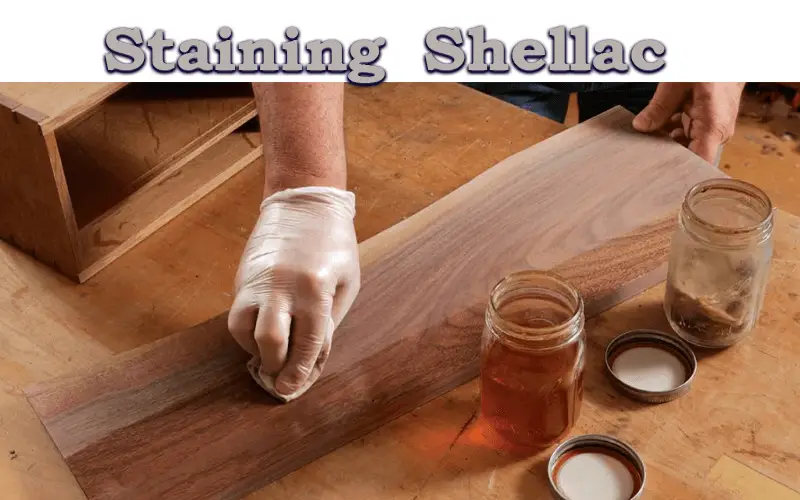Even after the wood has been sealed you can open up a whole new world of stain and tonal possibilities by adding a layer of stain (glazes or toners). This is true for all sealers or topcoats. Previously we checked staining over stains, polyurethane, and Varnishes.
To answer, can you stain over shellac, This article will cover the basics of glazing and toning wood sealed with shellac.
Related Topic: Stain over polyurethane
Can you stain over shellac – Staining shellac 101
Yes, you can stain over shellac. When you encounter a situation where the wood is sealed with shellac and you want to adjust the hue or color, staining is a viable option. Shellac acts as a reliable finish sealer and can easily accommodate a layer of stain on top of it.
However, it is important to ensure that the surface is properly prepared for successful application of stain over shellac. The key is to have a clean and dull surface, as any bonding issues can arise if the shellac is not properly prepped.
Shellac-stain compatibility
When it comes to determining compatibility between a stain and finish, the solvent or thinner used in each product plays a crucial role. Understanding the solvents involved can help you determine if a stain and finish are compatible.
- Water-Alcohol or Lacquer Thinner: If both the stain and finish use a solvent such as water-alcohol or lacquer thinner, it indicates compatibility between them. This means that the stain and finish can be used together without issues.
- Mineral Spirits: Compatibility can also be established if either the stain or finish uses mineral spirits as a solvent. If one product utilizes mineral spirits while the other uses a water-alcohol or lacquer thinner, they can still be considered compatible.
The reason behind this compatibility lies in the nature of dyes dissolved in solvents. A dye dissolved in a solvent can be redissolved by that same solvent, including the solvent used in the finish.
What happens if you stain over shellac?
Staining over shellac presents a couple of possibilities. If you are planning to stain on top of a shellac topcoat it’s good to know some of these possibilities in order to know what will work for you. While applying a normal stain is still ok buying a glaze and using it instead is not only easier but will give better results.
Depending on the type of stain/glaze/toner, and the application process you can alter
- The optical mechanism that highlights the depth and richness of wood
- Alter overall hue and value
- Control splotching
- Subdue stain brightness
- Imitate age
- Imitate grain
- Highlight pore structure
What finish can you put over shellac?

Almost all finishes can be applied on top of other finishes. The golden rule is the finish should be fully cured, clean, and dull.
In the case of shellac finish experts like Bob Flexner advise that any film-forming finish can go over a coat of shellac as long as the shellac is fully cured.
Stains that have binders will also go over shellac with no major problems. However, stains may need an extra layer of protection regardless of having a binder or not.
Can I paint on top of shellac?
Painting over shellac is absolutely doable. But should you? It depends. Painting unlike stains will obscure the wood underneath completely. So if you don’t care about the grain and figure of the wood then painting on top of the shellac sealer is ok.
The advantage of shellac when the painting is that it has already sealed the wood therefore a primer is not needed. The only time you may need a primer in such a scenario is if the wood is too dark and the paint may not block it with much success then a primer can be introduced to block out and lay a good foundation for a lighter color.
If your intended purpose is color that still shows the grain and figure of the wood then avoid paint and use stains instead.
Can shellac go over oil-based stain?
Shellac can seal your stained wood regardless of whether the stain is water or oil-based. As discussed above the fundamental rule is a cured, clean surface.
A light sanding before applying your protective layer of shellac ensures your surface is as even as possible.
How do you apply stain over shellac?

Surface prep
Surface preparation is quintessential to get a perfect finish. In surface prep, you will need to sand lightly the surface to ensure it is smooth. Be careful not to sand the entire shellac off unless that’s the intention. Sanding takes care of dirt that may be on the surface. On top of this sanding etch the shellac allowing mechanical bond between the existing coating and the stain to be applied later on.
cleaning the surface
After the sanding clean the surface to make sure no dust particles lay on the surface.
Applying the stain/glaze
To apply the stain you may use a brush, rug, or spray gun. After picking a method that best suits you apply the glaze evenly on the surface. Make sure it spreads to all the areas.
Wipe off excess
Wipe off the excess glaze right after the thinner has flashed off and the glaze has become dull. wiping off can be done with a rug but I prefer using a brush. With a brush, you can brush off excess each time drying your brush with a rug you get the consistency and color concentration you like. Keep the coat as thin as possible owing to the fact a topcoat awaits.
Recoat shellac
Once you have applied the glaze let it cure. once it’s cured you can go ahead and lock in the stain with a layer of shellac. Adding a new topcoat ensures that the stain underneath cannot be scratched or easily dented.
let the piece cure
Once your topcoat is fully cured your piece is ready but you do not have to stop here. If a rich depth or more finetuning of the hue and value is desired the process can be repeated.
However, if multiple coats are to be used then it’s wise to keep each layer as thin as possible for every new layer obscures the wood to some level.
The last layer should receive at least a double coat for extra protection. Also, the last layer doesn’t have to be shellac it could be lacquer or poly for the benefit of longevity.
How do you make shellac darker?
How do you make shellac darker? Darkening a finish is commonly known as toning, and it involves mixing a dye or pigment stain with a clear finish to achieve the desired color. In this process, the clear finish acts as the “vehicle” that carries the stain, allowing you to darken the shellac.
One popular method for darkening shellac is glazing, where the stain is applied between layers of clearcoat-like shellac. This technique creates a beautiful depth and richness to the finish, especially when using multiple layers of glaze.
However, if you prefer a simpler approach, you can directly add the stain to the shellac before application. Before proceeding, it’s essential to choose the right type of dye or pigment that is compatible with the shellac. Alcohol or oil-based dyes are suitable choices as they can be redissolved by shellac due to its solvent properties.
To darken shellac using this method, follow these steps:
- Select the appropriate dye or pigment: Choose a dye or pigment that complements the color you want to achieve. Alcohol or oil-based dyes are ideal because they will readily dissolve in shellac.
- Test on a sample piece: Before applying the darkened shellac to your final project, it’s essential to test the mixture on a scrap piece of wood to see how the color develops and if it matches your desired shade.
- Mix the dye or pigment with shellac: In a separate container, add a small amount of shellac, and then gradually add the dye or pigment. Stir thoroughly to ensure the color is evenly distributed throughout the shellac.
- Apply the darkened shellac: Using a brush, pad, or spray gun, apply the darkened shellac to your project in thin, even coats. Allow each coat to dry completely before adding additional layers.
- Finishing touches: After achieving the desired color, you can proceed with your preferred finishing techniques, such as sanding, buffing, or applying a protective topcoat if needed.
Another option is buying shellac flakes of a certain shade as shown in the pic below.

Can you stain over shellac – Summary
Staining over shellac is possible and opens up a world of possibilities. The application is not overly complex and anyone can use our outlined steps as discussed above.
In tackling can you stain over shellac we have covered much more regarding the glazing and toning process.
If you feel we have left out something or have any questions related to shellac and staining it please let us know in the comment section and we will reply diligently.


This was a great answer to my question!
Thank you, William! I’m glad to hear that you found the answer helpful. If you have any more questions or need further assistance, feel free to ask. I’m here to help!